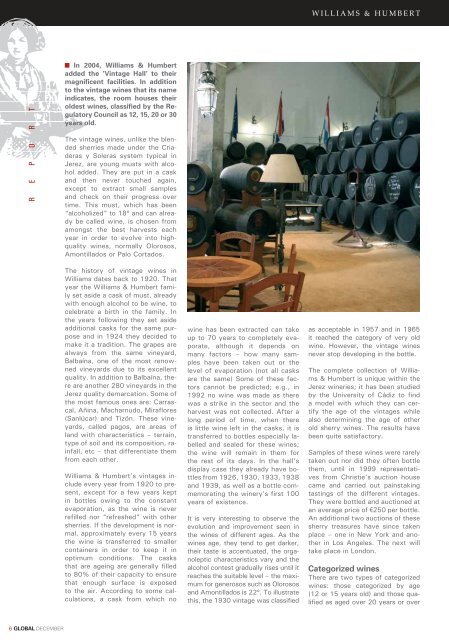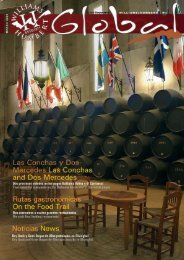sumariosummary - Bodegas Williams & Humbert
sumariosummary - Bodegas Williams & Humbert
sumariosummary - Bodegas Williams & Humbert
Create successful ePaper yourself
Turn your PDF publications into a flip-book with our unique Google optimized e-Paper software.
R E P O R T<br />
6 GLOBAL DECEMBER<br />
In 2004, <strong>Williams</strong> & <strong>Humbert</strong><br />
added the ‘Vintage Hall’ to their<br />
magnifi cent facilities. In addition<br />
to the vintage wines that its name<br />
indicates, the room houses their<br />
oldest wines, classifi ed by the Regulatory<br />
Council as 12, 15, 20 or 30<br />
years old.<br />
The vintage wines, unlike the blended<br />
sherries made under the Criaderas<br />
y Soleras system typical in<br />
Jerez, are young musts with alcohol<br />
added. They are put in a cask<br />
and then never touched again,<br />
except to extract small samples<br />
and check on their progress over<br />
time. This must, which has been<br />
“alcoholized” to 18º and can already<br />
be called wine, is chosen from<br />
amongst the best harvests each<br />
year in order to evolve into highquality<br />
wines, normally Olorosos,<br />
Amontillados or Palo Cortados.<br />
The history of vintage wines in<br />
<strong>Williams</strong> dates back to 1920. That<br />
year the <strong>Williams</strong> & <strong>Humbert</strong> family<br />
set aside a cask of must, already<br />
with enough alcohol to be wine, to<br />
celebrate a birth in the family. In<br />
the years following they set aside<br />
additional casks for the same purpose<br />
and in 1924 they decided to<br />
make it a tradition. The grapes are<br />
always from the same vineyard,<br />
Balbaína, one of the most renowned<br />
vineyards due to its excellent<br />
quality. In addition to Balbaína, there<br />
are another 280 vineyards in the<br />
Jerez quality demarcation. Some of<br />
the most famous ones are: Carrascal,<br />
Añina, Macharnudo, Miraflores<br />
(Sanlúcar) and Tizón. These vineyards,<br />
called pagos, are areas of<br />
land with characteristics – terrain,<br />
type of soil and its composition, rainfall,<br />
etc – that differentiate them<br />
from each other.<br />
<strong>Williams</strong> & <strong>Humbert</strong>’s vintages include<br />
every year from 1920 to present,<br />
except for a few years kept<br />
in bottles owing to the constant<br />
evaporation, as the wine is never<br />
refilled nor “refreshed” with other<br />
sherries. If the development is normal,<br />
approximately every 15 years<br />
the wine is transferred to smaller<br />
containers in order to keep it in<br />
optimum conditions. The casks<br />
that are ageing are generally filled<br />
to 80% of their capacity to ensure<br />
that enough surface is exposed<br />
to the air. According to some calculations,<br />
a cask from which no<br />
wine has been extracted can take<br />
up to 70 years to completely evaporate,<br />
although it depends on<br />
many factors – how many samples<br />
have been taken out or the<br />
level of evaporation (not all casks<br />
are the same) Some of these factors<br />
cannot be predicted; e.g., in<br />
1992 no wine was made as there<br />
was a strike in the sector and the<br />
harvest was not collected. After a<br />
long period of time, when there<br />
is little wine left in the casks, it is<br />
transferred to bottles especially labelled<br />
and sealed for these wines;<br />
the wine will remain in them for<br />
the rest of its days. In the hall’s<br />
display case they already have bottles<br />
from 1926, 1930, 1933, 1938<br />
and 1939, as well as a bottle commemorating<br />
the winery’s first 100<br />
years of existence.<br />
It is very interesting to observe the<br />
evolution and improvement seen in<br />
the wines of different ages. As the<br />
wines age, they tend to get darker,<br />
their taste is accentuated, the organoleptic<br />
characteristics vary and the<br />
alcohol contest gradually rises until it<br />
reaches the suitable level – the maximum<br />
for generosos such as Olorosos<br />
and Amontillados is 22º. To illustrate<br />
this, the 1930 vintage was classified<br />
as acceptable in 1957 and in 1965<br />
it reached the category of very old<br />
wine. However, the vintage wines<br />
never stop developing in the bottle.<br />
The complete collection of <strong>Williams</strong><br />
& <strong>Humbert</strong> is unique within the<br />
Jerez wineries; it has been studied<br />
by the University of Cádiz to find<br />
a model with which they can certify<br />
the age of the vintages while<br />
also determining the age of other<br />
old sherry wines. The results have<br />
been quite satisfactory.<br />
Samples of these wines were rarely<br />
taken out nor did they often bottle<br />
them, until in 1999 representatives<br />
from Christie’s auction house<br />
came and carried out painstaking<br />
tastings of the different vintages.<br />
They were bottled and auctioned at<br />
an average price of €250 per bottle.<br />
An additional two auctions of these<br />
sherry treasures have since taken<br />
place – one in New York and another<br />
in Los Angeles. The next will<br />
take place in London.<br />
Categorized wines<br />
There are two types of categorized<br />
wines: those categorized by age<br />
(12 or 15 years old) and those qualified<br />
as aged over 20 years or over



